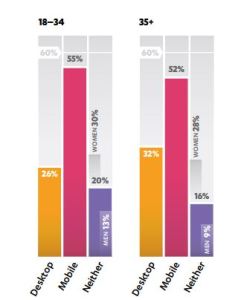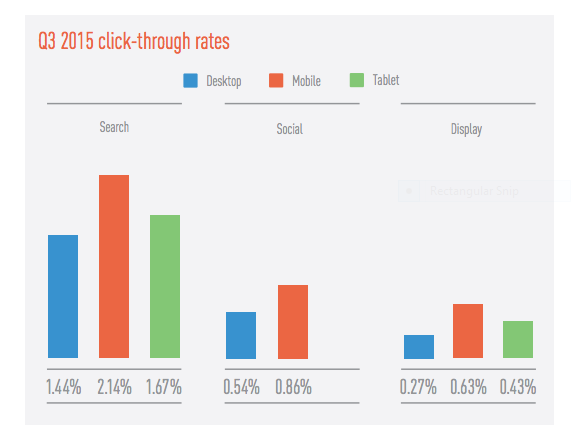As covered here and in numerous other blogs and studies, mobile Web traffic has grown exponentially over the last decade. With it has grown mobile ad click-through rates, which according to Adroit Digital’s research, outstrip CTRs for desktop in all age categories.

Users of all ages are more likely to click on mobile ads.
But for all their clicks, customers on their phones don’t seem to be converting at the same rate as when they’re sitting at their desktops.

Mobile conversion rates are 1/3 that of desktop.
So what’s a savvy digital marketer to do? Should we really be curbing our digital advertising spends in light of this research? Or does it lie within our power to improve conversions? Do we simply accept mobile’s role in the upper end of the purchasing funnel? All of the above?
Curb Mobile Ad Spend?
Search Engine Watch recently conducted an experiment with promoted tweets, keeping everything the same except for the targeted device (desktop vs. mobile). As expected, mobile garnered almost twice as many clicks but had a 60 percent lower conversion rate and a 160 percent higher acquisition cost.
This experiment is a powerful lesson to marketers – urging us to consider our end goals and budget in conjunction with the channel we’re using. It doesn’t mean we should abandon digital altogether, but perhaps we should curb our mobile ad spend when we’re looking to maximize certain conversions (such as downloading a white paper, which was the experiment’s CTA) and/or control cost-per-lead.
Improve Mobile Conversions – Or Change Definition?
Still, with some help from Unbounce, hope remains for both mobile landing pages and conversions. It’s ok to ask mobile users to complete a form, but that form had better be concise (four fields or less) and friendly, with fields auto switching the device’s keyboard from alpha to numeric where appropriate.
And perhaps instead of form completions or click-throughs, the real conversion we should be measuring on mobile is the click-to-call rate.

Phone calls are a great KPI to measure for mobile.
Calls may seem old-school in this day and age, but for all their intelligence, smartphones are still phones.
Accept It?
Of course, just because mobile ads/pages aren’t leading to instantaneous, quantifiable conversions, it doesn’t mean they’re not helping customers along their buying journeys. As Strands Retail points out, mobile is primarily used for upper funnel activities like product discovery, browsing, research and comparison.
Experiences? Opinions?
What’s been your experience with mobile conversion rates? Do you think they’ll ever catch up to desktop? Why or why not? Is that ok?


